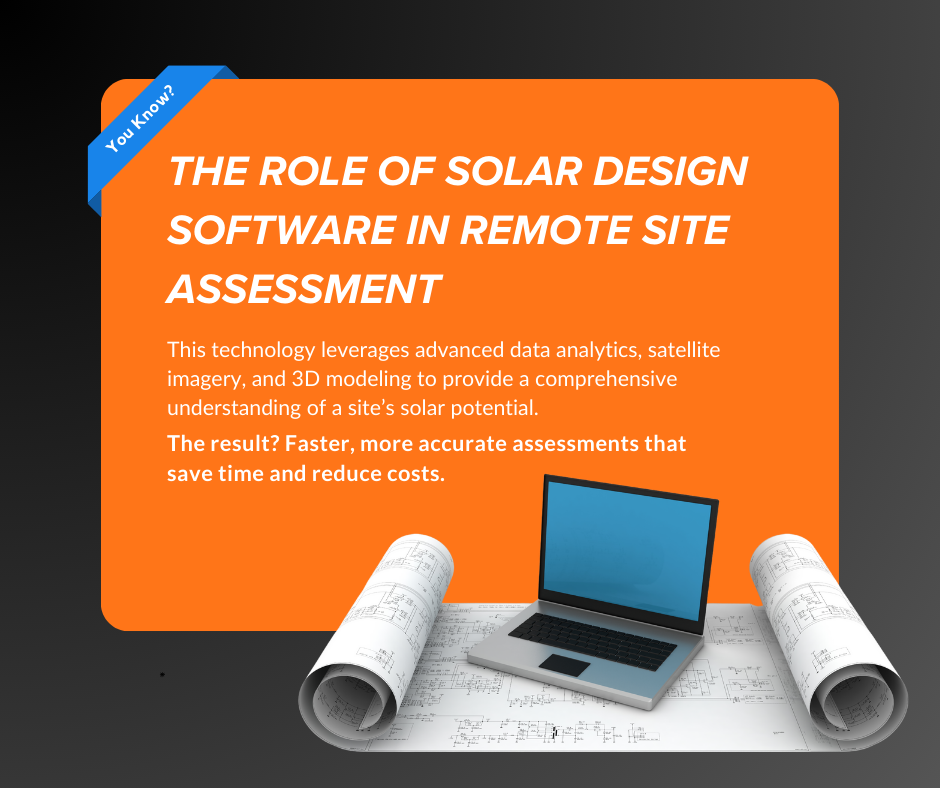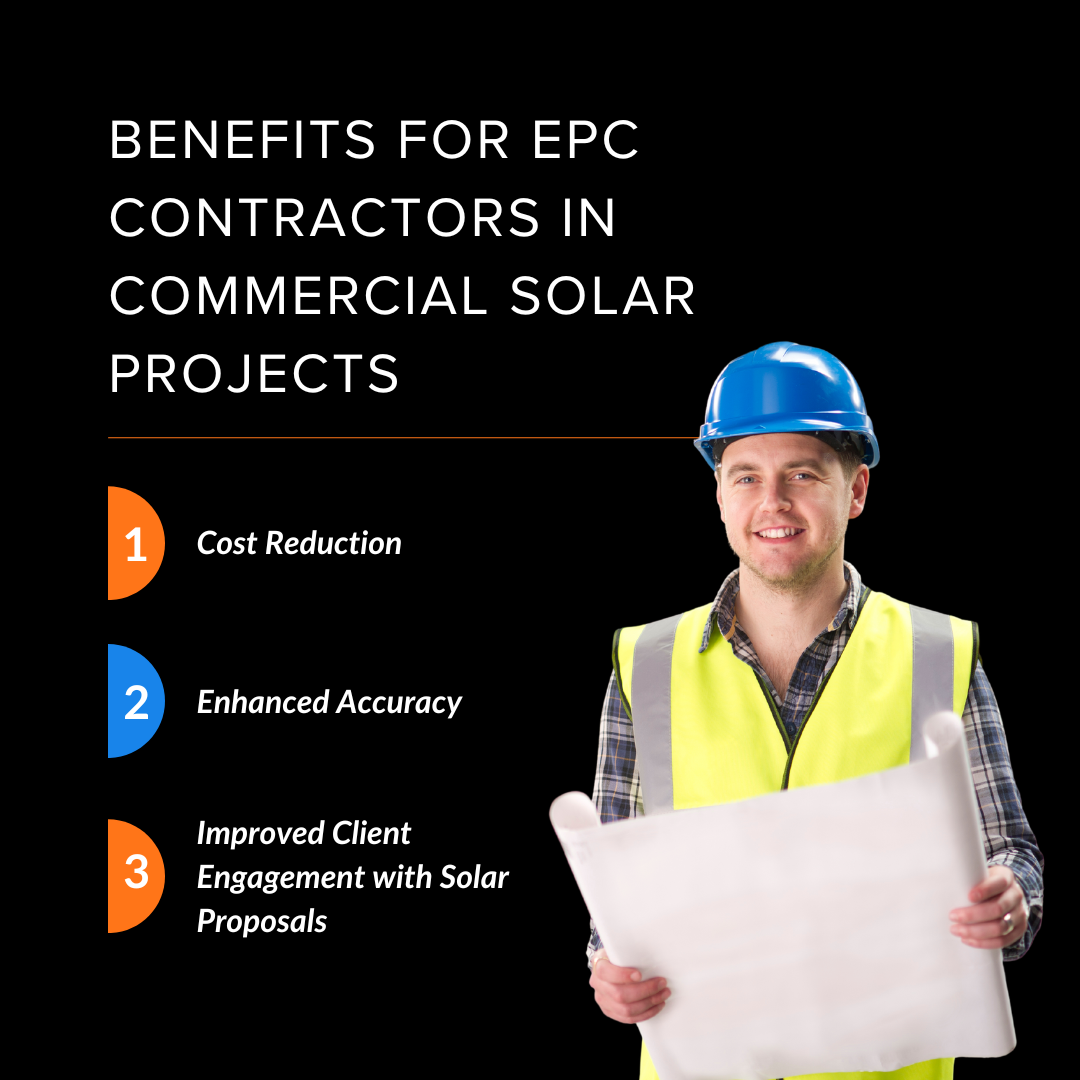October 9, 2024
Solar Design Software
The solar industry is booming, and with it comes the need for efficient and accurate site assessments. According to the Solar Energy Industries Association (SEIA), the U.S. solar market is projected to grow 42% from 2022 to 2027. For EPC (Engineering, Procurement, and Construction) contractors, evaluating a potential site remotely has become an indispensable part of the workflow.
Enter Solar design software: a game-changer that revolutionizes how these assessments are conducted.
This blog explores the pivotal role the best solar design software plays in remote site assessments, its key features, and the benefits it brings to EPC contractors in commercial solar projects.
The Role of Solar Design Software in Remote Site Assessment

Solar software has transformed the landscape of remote site assessments. It allows EPC contractors to conduct thorough evaluations without ever setting foot on the site. This technology leverages advanced data analytics, satellite imagery, and 3D modeling to provide a comprehensive understanding of a site’s solar potential.
The result? Faster, more accurate assessments that save time and reduce costs.
Key Features of Solar Design Software for Solar Professionals

Solar design software is a transformative tool for solar professionals, offering a range of features that enhance the accuracy, efficiency, and overall quality of solar project assessments.
These software solutions are designed to address the unique challenges of solar site evaluation, design, and implementation.
Here are some key features that make solar design software indispensable for solar professionals:
1. Remote Site Evaluation
User-Friendly Interface
One of the standout features of solar design software is its intuitive design. Even those who aren’t experts in solar technology can easily navigate the platform to conduct assessments.
The user-friendly interface ensures that the learning curve is minimal, allowing more professionals to leverage this technology effectively.
Instant Report Generation
Gone are the days of waiting weeks for a detailed site assessment report. With solar design software, reports can be generated instantly.
This quick turnaround aids in faster decision-making, allowing EPC contractors to move forward with projects more efficiently.
2. Advanced Data Integration
Solar design software seamlessly integrates various data sources, including satellite imagery, LiDAR data, and geographical information systems (GIS). This integration provides a holistic view of the site, considering factors like topography, vegetation, and existing structures, ensuring a more accurate assessment.
By integrating these data sources, solar installers can streamline their workflow, enhancing efficiency and effectiveness in their operations.
3. Shading Analysis and Energy Forecasting
Advanced Simulation Tools
Shading can significantly impact the efficiency of a solar installation. Advanced simulation tools within the software allow for detailed analysis of shading effects throughout the year.
These tools use algorithms to predict how shadows from nearby objects will affect solar panels, helping to optimize panel placement for maximized energy production.
Weather Data Integration
Accurate energy forecasting is crucial for any solar project. Solar design software integrates historical weather data to create precise energy production models.
This integration helps in predicting how much energy a site can generate, factoring in variations in sunlight due to seasonal changes and weather patterns.
4. 3D Modeling and Visualization
Visualizing Solar Potential
3D modeling is a powerful feature that assists in visualizing potential solar installations. By creating a digital twin of the site, EPC contractors can explore different design scenarios and their impacts on energy production.
This visualization helps in making informed decisions about panel placement and system configuration.
Customization Options
Every solar project is unique, and solar design software offers extensive customization options.
Whether adjusting for client-specific requirements or site-specific challenges, the software allows for tailored designs that meet the precise needs of each project.
5. Automated Design and Proposal Tools
Automated design and proposal tools are essential for streamlining the design process and enhancing efficiency. These tools automate repetitive tasks, such as creating layout designs, generating bills of materials, and producing client proposals.
This automation saves time and ensures consistency and accuracy in project documentation.
Read more: A Complete Guide to Using Solar Proposal Software
Benefits for EPC Contractors in Commercial Solar Projects

As the solar industry continues to expand, EPC contractors face increasing pressure to streamline operations and reduce costs. Solar design software provides a powerful solution, offering numerous benefits that enhance efficiency and accuracy.
Here are some of the key benefits that solar design software brings to commercial solar projects:
1. Cost Reduction
Reduced Travel Expenses
Remote assessments mean fewer site visits, significantly cutting down on travel-related costs. This reduction not only saves money but also reduces the carbon footprint associated with frequent travel.
Labor Cost Savings
Automated processes within the software reduce the need for extensive manual labor. Tasks that once took hours can now be completed in minutes, resulting in substantial labor cost savings.
2. Enhanced Accuracy
Minimizing Human Error
Manual assessments are prone to human error, which can lead to costly mistakes. Solar design software minimizes these errors by using precise algorithms and data validation techniques, ensuring more accurate assessments.
Data Validation Techniques
The software employs robust data validation methods to ensure the accuracy of the information used in assessments. This validation is crucial for making reliable predictions about energy production and project feasibility.
3. Improved Client Engagement with Solar Proposals
Adapting to Project Size
Whether the project is a small residential installation or a large commercial solar farm, solar design software can handle it all. Its scalability allows EPC contractors to adapt their approach based on the project size, ensuring efficient resource allocation.
Multi-Site Management Capabilities
Managing multiple projects simultaneously can be a logistical challenge. Solar design software offers multi-site management capabilities, allowing contractors to keep track of various projects from a single platform, streamlining operations and improving project oversight.
Wrapping Up
Solar design software has undoubtedly revolutionized the way EPC contractors conduct remote site assessments. A standout example of this transformative technology is Sunbase Design Software. Sunbase offers a robust suite of features that cater to the unique needs of EPC contractors, making it an essential tool for those aiming to streamline their operations and improve project outcomes.
With Sunbase, contractors can conduct remote site evaluations with precision, integrate various data sources seamlessly, and generate instant, detailed reports. Its advanced shading analysis, energy forecasting capabilities, and 3D modeling tools empower contractors to optimize solar installations effectively.
Know more about- Regulatory Changes with Sunbase Solar Solutions
About Sunbase Solar Design Software
Sunbase transforms the way solar companies and professionals design and manage their solar systems with our advanced, user-friendly software.
For any solar business aiming to excel, Sunbase is indispensable as it boosts proposal quality, helps to generate exceptional PV designs, quickens the sales cycle, and provides a significant competitive advantage.
Reach out to Sunbase
Optimize efficiency, slash costs, and deliver solar projects faster with Sunbase Solar Design Software & Solar Proposal Software.
Are you ready to take your business to the next level? Contact us and let's talk.
Frequently Asked Questions
Q1: How does solar design software integrate weather data?
Ans- Solar design software uses historical weather data to predict future energy production, accounting for variations in sunlight due to seasonal changes and weather patterns.
Q2: Can solar design software handle large commercial projects?
Ans- Yes, solar design software is scalable and can manage both small residential installations and large commercial solar farms.
Q3: What are the main cost benefits of using solar design software?
Ans- The main cost benefits include reduced travel expenses, labor cost savings, and minimized human errors, leading to more accurate and efficient project assessments. Additionally, uploading an electric bill can contribute to cost savings by enabling personalized and precise project design for your solar system.
I agree to receive marketing messaging from Sunbase at the phone number provided above. I understand data rates will apply, and can reply STOP to OPT OUT.







